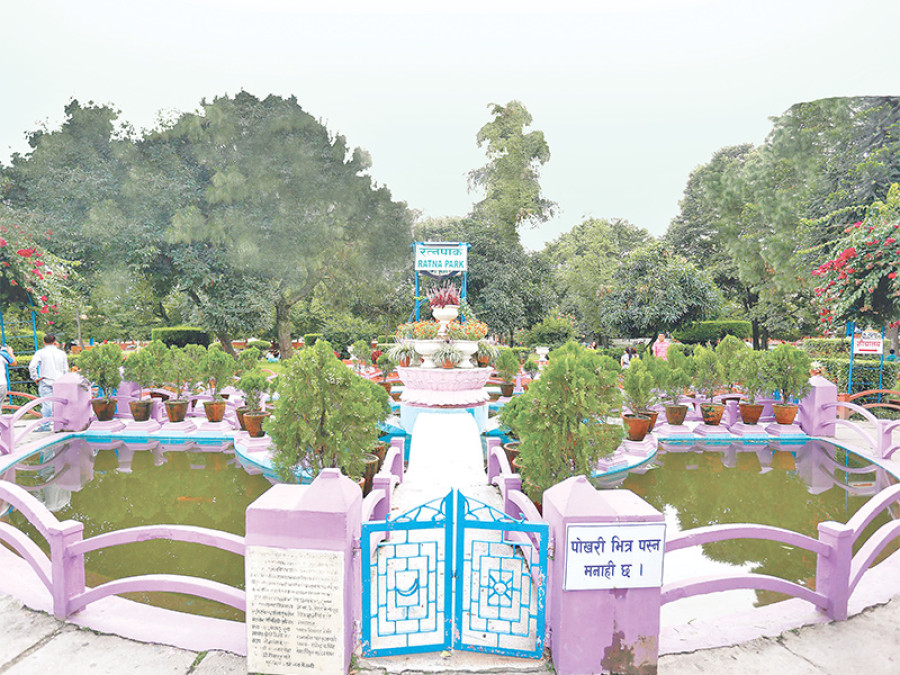Miscellaneous
R&R at Ratna Park
When I was growing up, Ratna Park represented for me a place of mystery: I imagined what its soul was like from the many stories I heard about it.
Alisha Sijapati
When I was growing up, Ratna Park represented for me a place of mystery: I imagined what its soul was like from the many stories I heard about it. Most of these stories were of the sordid kind: that this dilapidated island in the middle of the metropolis was the refuge of beggars and bums during the afternoons, and that when the sun set, it turned into a hive of nefarious activities. I’d heard that this dirty conclave—dotted with concrete gazebo-like structures (whose paint seemed to have been peeled off by the glare of some relentless sun); built around two ponds clogged with fetid water and pockmarked carp; the whole area fenced off from the rest of humanity by runty hedges and trellised three-foot walls that had long lost their allure—turned into the perfect haven for drug addicts seeking oblivion in that next hit of brown sugar, or lonely men seeking solace in the arms of a prostitute.

Whenever I was in the area, changing buses for my next destination, in the bus depots right outside Ratna Park’s boundaries, I’d try to peek through the crowds to catch a glimpse of the park. More often than not, I would see people lazing in the sun, peeling oranges or shelling peanuts. And on windy days, I’d sometimes observe mini dust whirlwinds gathering bits of trash—plastic bags, candy wrappers and scraps of paper—and scattering them on the dust-caked earth once they were spent of their force. I had ventured into the park once in a while, but the overall sense I got of the place was that it was a dull, decrepit hole that sapped your energy.

A couple of months ago, I heard that the park had been renovated and been reopened to the public. My curiosity was piqued. I wanted to see if the 42-ropani park had indeed shed its dismal history and been transformed into an oasis where a Kathmanduite could find some reprieve from the daily chaos.
As I was paying the Rs 25 entrance fee to the newly done-up park, I tried to sneak a peek, as I used to do in bygone years. I was met with the sight of lovebirds perched atop the park’s benches. When I walked into the premises, I saw old ladies napping on the grass, children squealing as they oscillated from the swings, people lazing under the boughs of a pipal tree. The sights were somewhat similar to the ones that I’d had espied growing up—when I would sneak in peeks from the windows of a microbus. But there seemed to be a different atmosphere to the place this time around. There seemed to be a serenity now and even the couples and packs of people taking selfies every now and then didn’t disrupt this ambience. If anything, such activity only seemed to add verve to the placid setting.

I parked myself under a tree, leaned against its trunk and took in my surroundings. Pretty soon, I found myself closing my eyes, as the rhythms of the sounds in the park drowned out the squeals, screeches and honking outside. I also found snatches of the old sordid stories about the park starting to flicker inside my head. But they were soon dispelled by the rustle of the fallen leaves, the rhythmic troughs and peaks in the voices of the people on the benches spinning stories for their companions. When I opened my eyes again, I faced a Kathmandu framed from inside the hedges of the park. I’d have to wade back into that larger chaos again soon. But I wanted to stay back just a little bit longer.
Photos: Sanjog Manandhar












 17.12°C Kathmandu
17.12°C Kathmandu








%20(1).jpg&w=300&height=200)

